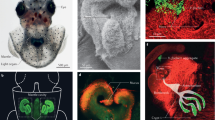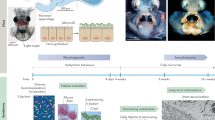Abstract
In most symbioses between animals and luminous bacteria it has been assumed that the bacterial symbionts luminesce continuously, and that the control of luminescent output by the animal is mediated through elaborate accessory structures, such as chromatophores and muscular shutters that surround the host light organ. However, we have found that while in the light organ of the sepiolid squid Euprymna scolopes, symbiotic cells of Vibrio fischeri do not produce a continuously uniform level of luminescence, but instead exhibit predictable cyclic fluctuations in the amount of light emitted per cell. This daily biological rhythm exhibits many features of a circadian pattern, and produces an elevated intensity of symbiont luminescence in juvenile animals during the hours preceding the onset of ambient darkness. Comparisons of the specific luminescence of bacteria in the intact light organ with that of newly released bacteria support the existence of a direct host regulation of the specific activity of symbiont luminescence that does not require the intervention of accessory tissues. A model encompassing the currently available evidence is proposed for the control of growth and luminescence activity in the E. scolopes/V. fischeri light organ symbiosis.
Similar content being viewed by others
Abbreviations
- CFU :
-
colony-forming-unit
- LD :
-
light-dark
References
Boettcher KJ, Ruby EG (1990) Depressed light emission by symbiotic Vibrio fischeri of the sepiolid squid Euprymna scolopes. J Bacteriol 172: 3701–3706
Boettcher KJ, Ruby EG (1995) Detection and quantification of Vibrio fischeri autoinducer from symbiotic squid light organs. J Bacteriol 177: 1053–1058
Dunlap PV (1985) Osmotic control of luminescence and growth in Photobacterium leiognathi from ponyfish light organs. Arch Microbiol 141: 44–50
Dunlap PV (1991) Organization and regulation of bacterial luminescence genes. Photochem Photobiol 54: 1157–1170
Dunlap PV, Greenberg EP (1985) Control of Vibrio fischeri luminescence gene expression in Escherichia coli by cyclic AMP and cyclic AMP receptor protein. J Bacteriol 164: 45–50
Eberhard A, Burlingame AL, Eberhard C, Kenyon GL, Nealson KH, Oppenheimer NJ (1981) Structural identification of autoinducer of Photobacterium fischeri luciferase. Biochemistry 20: 2444–2449
Edmunds LN (1988) Cellular and molecular bases of biological clocks. Springer, Berlin Heidelberg New York
Engebrecht J, Silverman M (1984) Identification of the genes and gene products necessary for bacterial bioluminescence. Proc Natl Acad Sci USA 81: 31–44
Hastings JW, Rusak B, Boulous Z (1991) Circadian rhythms: the physiology of biological timing. In: Prosser CL (ed) Neural and integrative animal physiology. Wiley-Liss, NY, pp 435–546
Haygood MG, Nealson KH (1985) Mechanisms of iron regulation of luminescence in Vibrio fischeri. J Bacteriol 162: 209–216
Kaplan HB, Greenberg EP (1985) Diffusion of autoinducer is involved in regulation of the Vibrio fischeri luminescence system. J Bacteriol 163: 1210–1214
Lee K-H, Ruby EG (1994) Effect of the squid host on the abundance and distribution of symbiotic Vibrio fischeri in nature. Appl Environ Microbiol 60: 1565–1571
McFall-Ngai MJ (1991) Luminous bacterial symbiosis in fish evolution: adaptive radiation among the leiognathid fishes. In: Margulis L, Fester R (eds) Symbiosis as a source of evolutionary innovation. MIT Press, Cambridge, 381–409
McFall-Ngai MJ, Dunlap PV (1983) Three new modes of luminescence in the leiognathid fish Gazza minuta: Discrete projected luminescence, ventral body flash, and buccal luminescence. Mar Biol 73: 227–237
McFall-Ngai MJ, Montgomery MK (1990) The anatomy and morphology of the adult bacterial light organ of Euprymna scolopes Berry (Cephalopoda: Sepiolidae). Biol Bull 179: 332–339
McFall-Ngai M, Ruby EG (1991) Symbiont recognition and subsequent morphogenesis as early events in an animal-bacterial mutualism. Science 254: 1491–1494
Meighen EA (1988) Enzymes and genes from the lux operons of bioluminescent bacteria. Annu Rev Microbiol 42: 151–176
Meighen EA, Dunlap PV (1993) Physiological, biochemical and genetic control of bacterial bioluminescence. Adv Microbiol Physiol 34: 1–67
Montgomery MK, McFall-Ngai MJ (1993) Embryonic development of the light organ of the sepiolid squid Euprymna scolopes Berry. Biol Bull 184: 296–308
Montgomery MK, McFall-Ngai MJ (1994) Bacterial symbionts induce host organ morphogenesis during early postembryonic development of the squid Euprymna scolopes. Development 120: 1719–1729
Morin JG, Harrington A, Nealson K, Krieger H, Baldwin TO, Hastings JW (1975) Light for all reasons: versatility in the behavioral repertoire of the flashlight fish. Science 190: 74–76
Moynihan M (1983) Notes on the behavior of Euprymna scolopes (Cephalopoda: Sepiolidae). Behavior 85: 25–41
Nealson KH (1977) Autoinduction of bacterial luciferase. Occurrence, mechanism and significance. Arch Microbiol 112: 73–79
Nealson KH, Hastings JW (1979) Bacterial bioluminescence: its control and ecological significance. Microbiol Rev 43: 469–518
Nealson KH, Hastings JW (1991) The luminous bacteria. In: Balows A, Truper HG, Dworkin M, Harder W, Schleifer K-H (eds) The prokaryotes, a handbook on the biology of bacteria: ecophysiology, isolation, identification, applications, 2nd edn. Springer Berlin Heidelberg New York, pp 1332–1345
Ruby EG, Asato L (1993) Growth and flagellation of Vibrio fischeri during initiation of the sepiolid squid light organ symbiosis. Arch Microbiol 159: 160–167
Ruby EG, McFall-Ngai MJ (1992) A squid that glows in the nightdevelopment of an animal-bacterial mutualism. J Bacteriol 174: 4865–4870
Wei SL, Young RE (1989) Development of symbiotic bacterial bioluminescence in a nearshore cephalopod, Euprymna scolopes. Mar Biol 103: 541–546
Author information
Authors and Affiliations
Rights and permissions
About this article
Cite this article
Boettcher, K.J., Ruby, E.G. & McFall-Ngai, M.J. Bioluminescence in the symbiotic squid Euprymna scolopes is controlled by a daily biological rhythm. J Comp Physiol A 179, 65–73 (1996). https://doi.org/10.1007/BF00193435
Accepted:
Issue Date:
DOI: https://doi.org/10.1007/BF00193435




